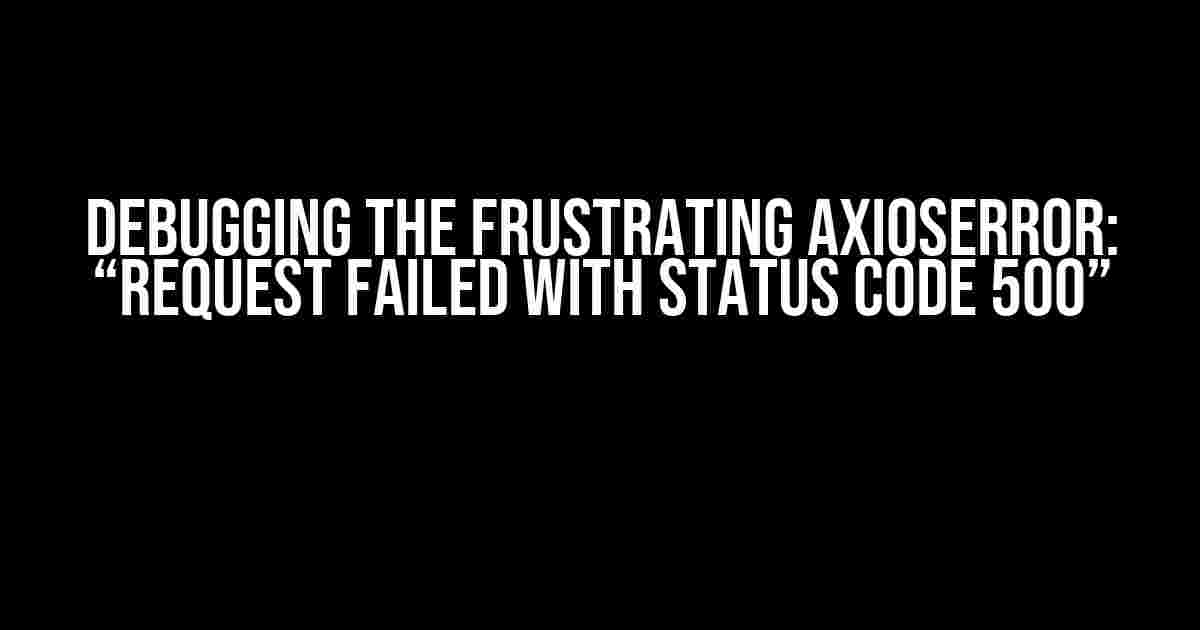Are you tired of seeing the dreaded “Request failed with status code 500” error message whenever you make an Axios request? You’re not alone! This error can be frustrating, especially when you’re not sure what’s causing it. In this article, we’ll dive deep into the world of Axios errors and provide you with step-by-step instructions on how to debug and fix this pesky issue.
What is an AxiosError?
An AxiosError is an error object returned by Axios when a request fails. It contains information about the error, including the message, name, and code. In this case, the error message is “Request failed with status code 500”, which indicates that the server encountered an internal error while processing the request.
AxiosError {
message: 'Request failed with status code 500',
name: 'AxiosError',
code: 'ERR_BAD_RESPONSE'
}
Why Am I Getting This Error?
There are several reasons why you might be getting this error. Here are some common causes:
- Server-Side Errors: The server might be experiencing issues, such as database connection problems, syntax errors, or resource shortages, that prevent it from processing the request.
- Network Connectivity Issues: Your network connection might be unstable or interrupted, causing the request to fail.
- Invalid Request Parameters: You might be sending invalid or malformed request parameters, such as incorrect headers, query parameters, or payload data.
- Axios Configuration Issues: Your Axios instance might be misconfigured, leading to errors when making requests.
Step-by-Step Debugging Guide
Don’t worry, we’ve got you covered! Follow these steps to debug and fix the “Request failed with status code 500” error:
- Check the Server Logs: Review the server logs to identify any errors or issues that might be causing the problem. This will give you valuable insights into what’s happening on the server-side.
- Verify Network Connectivity: Ensure that your network connection is stable and working correctly. Try pinging the server or checking your internet connection to rule out any issues.
- Inspect Request Parameters: Double-check your request parameters to ensure they are valid and correctly formatted. Use tools like Postman or cURL to test your requests and verify the output.
- Verify Axios Configuration: Review your Axios instance configuration to ensure it’s correctly set up. Check the
baseURL,timeout, andheadersoptions to ensure they’re correctly configured. - Enable Debugging: Enable debugging in Axios by setting the
debugoption totrue. This will provide more detailed error information to help you debug the issue.
import axios from 'axios';
axios.create({
baseURL: 'https://example.com/api',
timeout: 10000,
headers: {
'Content-Type': 'application/json'
},
debug: true
});
Common Solutions
Based on the error message and the debugging steps above, here are some common solutions to the “Request failed with status code 500” error:
| Solution | Description |
|---|---|
| Check Server Logs | Review server logs to identify and fix server-side errors. |
| Verify Network Connectivity | Ensure a stable network connection to rule out connectivity issues. |
| Fix Request Parameters | Verify and correct request parameters to ensure they are valid and correctly formatted. |
| Update Axios Configuration | Verify and update Axios configuration options to ensure correct setup. |
Conclusion
The “Request failed with status code 500” error can be frustrating, but with these steps and solutions, you should be able to debug and fix the issue. Remember to always check the server logs, verify network connectivity, inspect request parameters, and review Axios configuration. By following these guidelines, you’ll be well on your way to resolving this error and ensuring your Axios requests are successful.
Happy debugging!
Frequently Asked Question
Stuck with the infamous AxiosError? Don’t worry, we’ve got you covered! Here are some common questions and answers to help you troubleshoot and solve the issue.
What is AxiosError and why am I getting it?
AxiosError is an error object thrown by Axios, a popular JavaScript library for making HTTP requests. You’re getting this error because your request failed with a 500 status code, which means the server encountered an unexpected condition that prevented it from fulfilling the request.
What does the ERR_BAD_RESPONSE code mean?
The ERR_BAD_RESPONSE code indicates that the response from the server was invalid or couldn’t be parsed. This could be due to a server-side issue, a misconfigured API, or even a network problem.
How can I debug the AxiosError?
To debug the AxiosError, you can try logging the error object to the console using console.error(error) or console.log(error). This will give you more information about the error, including the request and response data. You can also use the Axios config option to enable debugging mode, which will provide more detailed error messages.
What could be causing the server-side issue?
The server-side issue could be due to a variety of reasons, such as a bug in the server-side code, a database connection issue, or a misconfigured server. Check the server logs to see if there are any error messages that can give you a clue about what’s going on. You can also try contacting the server admin or the API provider to see if they’re experiencing any issues.
How can I prevent AxiosError in the future?
To prevent AxiosError in the future, make sure to handle errors properly by catching and logging them. You can also implement retry mechanisms to retry failed requests, or use a circuit breaker pattern to prevent cascading failures. Additionally, ensure that you’re using the latest version of Axios and that your server-side code is robust and well-tested.



